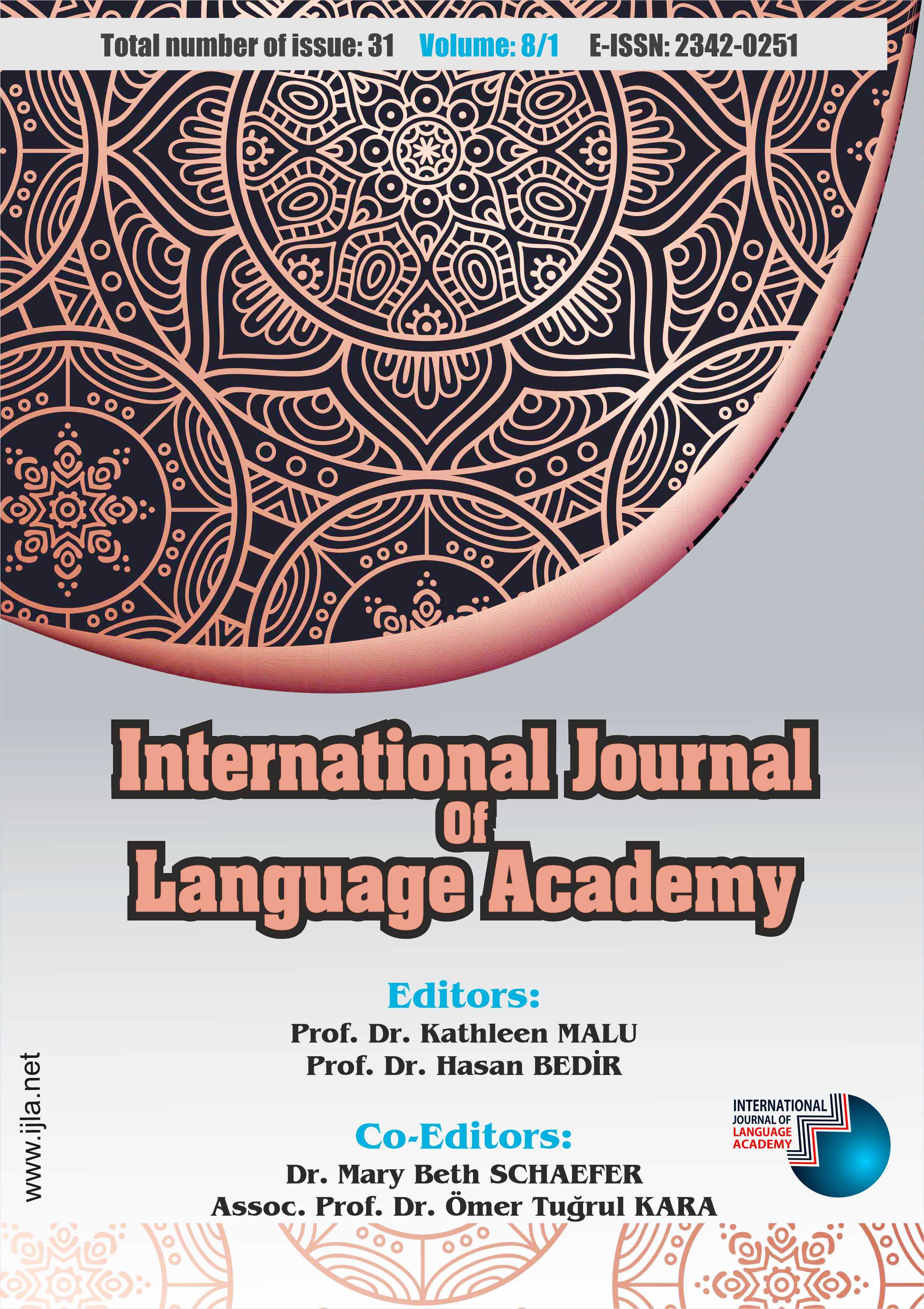Author :
Abstract
Bilimsel metinlerin yansız ve kişi bildirmeyen yapılarla oluşturulduğu görüşü özellikle Hyland (2005)’in kişilerarası üstsöylem modeli ile eleştirilmiştir. Yazarlar önerme içeriğine ve okura bakış açılarını yansıtarak, kendilerini metin içinde açıkça kodlayarak ve okuru söylem katılımcısı olarak metne dahil ederek öznelliklerini göstermek amacıyla sıklıkla bir takım stratejiler kullanırlar. Bu stratejiler alıcı odaklı etkileşimli üstsöylem olarak adlandırılır. Birinci tekil ve çoğul kişi bu üstsöylemsel işlevleri yansıtmak için kullanılabilen dilsel birimlerdir. Bu çalışmanın amacı biyoloji ve dilbilim makale özetlerindeki birinci tekil ve çoğul kişi kullanımlarını ve bu dilsel birimlerin üstsöylemsel işlevlerini belirlemektir. Çalışmada 150 makaleden oluşan bir veritabanı (75 biyoloji özeti ve 75 dilbilim özeti) oluşturulmuş, birinci tekil ve çoğul kişi kullanımları belirlenmiş ve bu kullanımlar üstsöylem çerçevesinde sınıflandırılmıştır. Yapılan incelemeye göre biyoloji ve dilbilim makale özetlerindeki bu dilsel birimlerin sıklıkları ve üstsöylemsel işlevleri arasında farklılıklar olduğu bulgulanmıştır.
Keywords
Abstract
The view that scientific texts are formed with neutral and impersonal structures has been criticized especially by Hyland (2005) with the interpersonal model of metadiscourse. The writers use frequently some strategies to express their subjectivity through reflecting of their perspective towards propositional content and readers, encoding themselves explicitly in the text and including the reader as a discourse participant. These strategies are called interactional metadiscourse markers. The first person singular and plural are linguistic units that can be used to reflect these metadiscursive features. The aim of this study is to determine the first person singular and plural uses in the research article abstracts of biology and linguistics, and the metadiscursive functions of these linguistic units. In this study, a database of 150 articles, (75 abstracts from biology and 75 abstracts from linguistics) was built, the first person single and plural uses in this database were determined and the functions of these uses in the text were classified within the framework of the metadiscourse. According to the data obtained in the study, it was found that there are differences between the frequency and metadiscursive functions of these linguistic units in biology and linguistics article abstracts.
Keywords
- Ädel, A. (2006). Metadiscourse in L1 and L2 English. Amsterdam, NE: John Benjamins.
- Ädel, A. ve Mauranen, A. (2010). Metadiscourse: Diverse and divided perspectives. Nordic Journal of English Studies. 9(2):1-11.
- Bayyurt, Y. ve Akbaş, E. (2014). Akademik metinlerde kaçınma ve vurgulayıcı ifadelerin lisansüstü öğrenciler tarafından algılanması ve kullanılması. S. N. Büyükkantarcıoğlu, I. Özyıldırım, E. Yarar ve E. Yağlı (Yay. Haz.), 27. Ulusal Dilbilim Kurultayı Bildirileri. (ss.72-79) içinde. Ankara: Hacettepe Üniversitesi.
- Bhatia, V. K. (2013). Analysing genre: Language use in professional settings. New York, NY: Routledge.
- Bordage, G. ve McGaghie, W. C. (2001). Title, authors and abstract. Academic medicine, 76(9): 945-947.
- Busch-Lauer, I. (2012). Abstracts-eine facettenreiche Textsorte der Wissenschaft. Linguistik Online, 52(2): 5-22.
- Crismore, A. (1983). Metadiscourse: What is it and how is it used in school and non-school Social Science Texts. Illinois, IL: University of Illinois.
- Crismore, A., Markkanen, R. ve Steffensen, M. S. (1993). Metadiscourse in persuasive writing: A study of texts written by American and Finnish university students. Written Communication, 10(1):39-71.
- Fløttum, K., Dahl, T. ve Kimm, T. (2006). Academic voices, across languages and disciplines. Amsterdam, NE: John Benjamins.
- Gillaerts, P. ve Van de Velde, F. (2010). Interactional metadiscourse in research article abstracts. Journal of English for Academic Purposes, 9: 128-139.
- Golebiowski, Z. (2009). Prominent messages in education and applied linguistics abstracts: How do authors appeal to their prospective readers?. Journal of Pragmatics, 41: 753-769.
- Huemer, B., Rheindorf, M. ve Gruber, H. (2012). Abstract, exposé und förderantrag. Wien, GE: Böhlau Verlag.
- Hyland, K. (1998). Persuasion and context: The pragmatics of academic metadiscourse. Journal of Pragmatics, 30:437-455.
- Hyland, K. (2000). Disciplinary discourses: Social interactions in academic writing. Singapore, SG: Pearson.
- Hyland, K. (2005). Metadiscourse. Exploring interaction in writing. London, UK: Continuum.
- Hyland, K. (2010). Metadiscourse: Mapping interactions in academic writing. Nordic Journal of English Studies, 9(2): 125-143.
- Hyland, K. (2014). Disciplinary discourse: Writer stance in research article. C. N. Candlin ve K. Hyland (Ed.), Writing: Texts, processes and practices (ss.99-121) içinde. K. New York, NY: Routledge.
- Hyland, K. (2015). Metadiscourse (2. Cilt). K. Tracy (Ed.), The international encyclopedia of language and social interaction (ss.997-1007) içinde. Chichester, UK: John Wiley&Sons.
- Hyland, K. (2017). Metadiscourse: What is it and where is it going? Journal of Pragmatics, 111: 16-29.
- İşeri, K. (2017). Sözden yazıya dile gelen metin. Ankara: Pegem Akademi.
- Jiang, F. K. ve Hyland, K. (2017). Metadiscursive nouns: Interaction and cohesion in abstract moves. English for Specific Purposes, 46: 1-14.
- Khedri, M., Heng, C. S. ve Ebrahimi, S. F. (2013). An exploration of interactive metadiscourse markers in academic research article abstracts in two disciplines. Discourse Studies, 15(3): 319-331.
- Martin-Martin, P. (2003). A Genre analysis of English and Spanish research paper abstracts in experimental social sciences. English for Specific Purposes, 22: 25-43.
- Mur-Duenas, P. (2011). An intercultural analysis of metadiscourse features in research articles written in English and in Spanish. Journal of Pragmatics, 43:3068-3079.
- Samraj, B. (2016). Research Articles. K. Hyland ve P. Shaw (Ed.), The Routledge Handbook of English for Academic Purposes (ss.403-415) içinde. New York, NY: Routledge.
- Uluçam-Wegmann, A. I. (2018). Birinci ve ikinci dilde metin türüne özgü yazma: Benzerlikler, farklılıklar ve etkileşimler. N. E. Uzun ve B. Bozkurt (Ed.), Türkçenin Eğitimi-Öğretiminde Kuramsal ve Uygulamalı Çalışmalar-10 (ss.37-74). içinde. İstanbul: Okan Üniversitesi Yayınları.
- Vande Kopple, W. J. (1985). Some exploratory discourse on metadiscourse. College Composition and Communication, 36(1): 82-93.
- Varastehnezhad, M. ve Gorjian, B. (2018). A Comparative study on the uses of metadiscourse markers (MMs) in research articles (RAs): Applied linguistics versus politics. Journal of Applied Linguistics and Language Learning, 4(2):30-39.
- Wei, J. ve Duan, J. (2019). A comparative study of metadiscoursal features in English research article abstracts in hard disciplines. Arab Journal of Applied Linguistics, 4(1):1-37.
